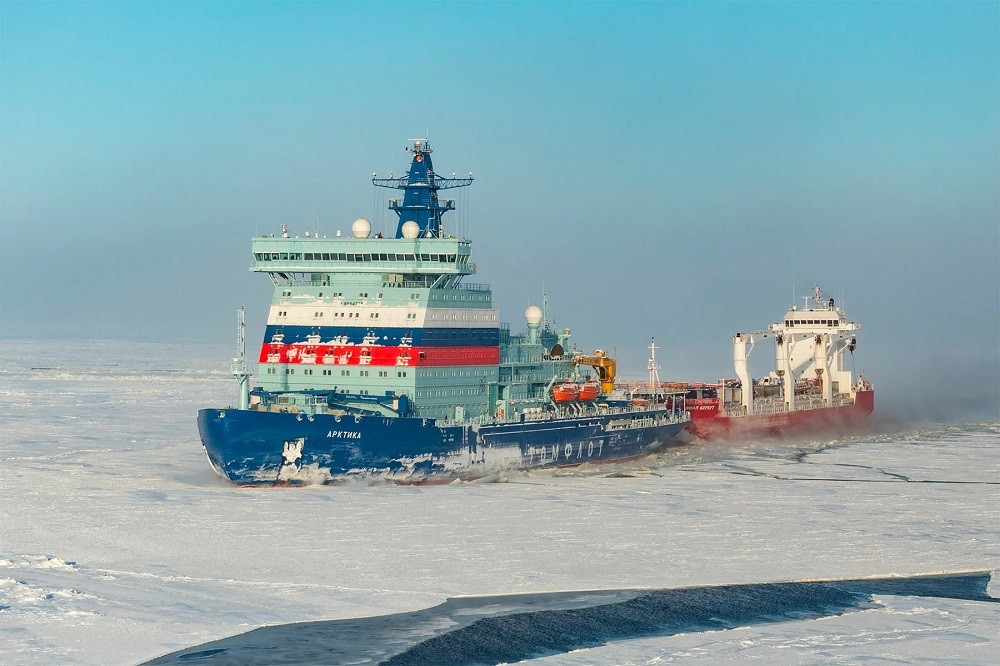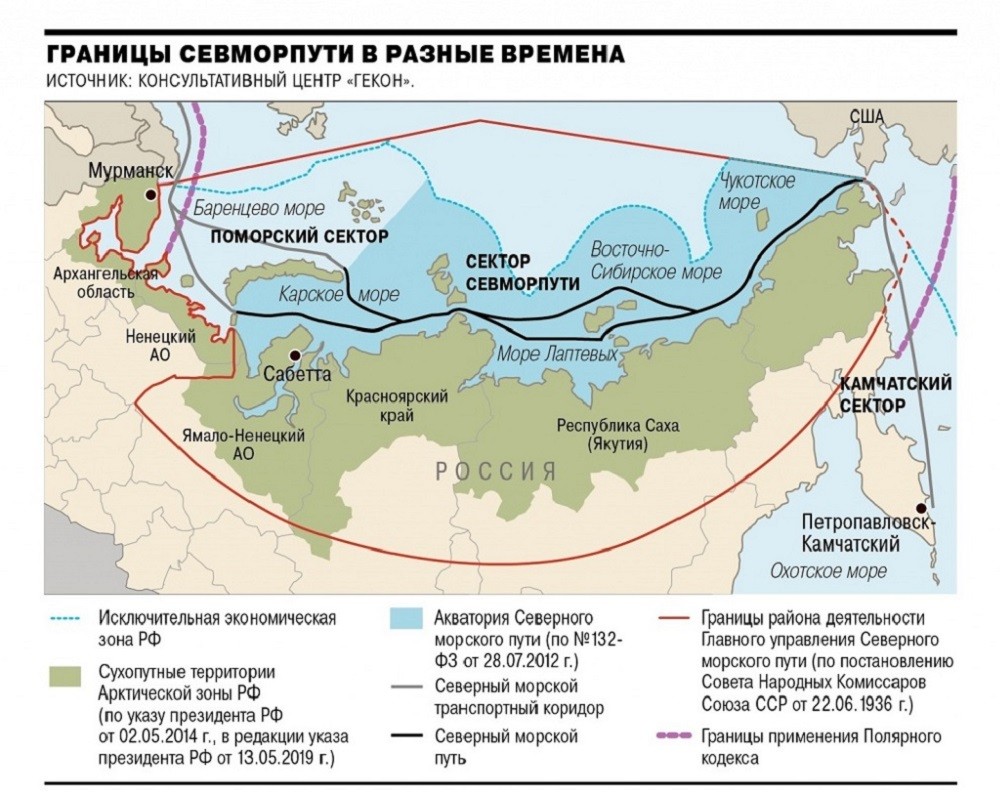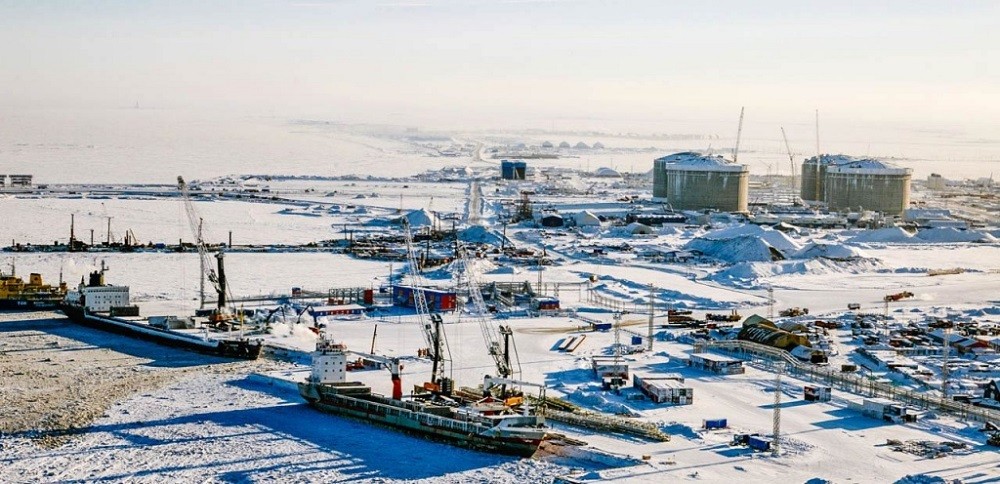
Nuclear icebreaker “Arctic”
NSR: Russian or international transport corridor?
Interest in the Arctic and its resources has been steadily growing in recent years, both from traditional Arctic powers and non–regional players. And this is not surprising: according to scientists, there are huge undiscovered reserves of natural resources in the Arctic, and the region itself occupies a strategic position.
The Northern Sea Route (hereinafter – the NSR) is a shipping route in the Russian Arctic. The main attention is now focused on it both in Russia and abroad: the Northwest Passage, which runs through the territorial waters and the exclusive economic zone of Denmark (Greenland Island), Canada and the USA, is frozen most of the year and has a much shorter navigation period than the NSR.
The NSR is the shortest route between the European part of Russia and the Far East. It runs through the seas of the Arctic and Pacific Oceans from the Kara Gate to Providence Bay. The total length of the NSR in this section is approximately 5,600 km, so this route is almost twice as short as other sea routes from Europe to the Far East.
Currently, the NSR mainly transports fuel and energy raw materials and equipment for field development and infrastructure construction.
Russian legislation on merchant shipping sets the boundaries of the NSR water area. But despite the fact that the NSR lies in the territorial waters and the exclusive economic zone of Russia, its development has many international aspects: the route attracts the attention of many regional and non-regional players.
The “National Transport Artery” of Russia

The map of the NSR. Source: Gecon Advisory Center.
The Arctic is a strategically important region for Russia: accounting for about 18% of the entire territory of Russia, it generates 11% of national income, creates 22% of Russia’s exports and produces about 80% of natural gas and 60% of oil. The development of the Arctic is impossible without the appropriate infrastructure, first of all, transport.
Now the drop in demand for energy resources has two effects: on the one hand, a decrease in demand has led to a reduction in production and a decrease in the volume of resources in need of transportation. On the other hand, the decreased demand has led to the fact that the implementation of large Arctic projects in the field of field development has temporarily lost its economic meaning.
A number of companies have already announced the postponement of the launch of new mining and processing facilities. Experts believe that with the recovery of demand for energy resources in the medium term, the NSR will be able to reach its targets again. In this case, in 2030, the volume of cargo transportation will amount to 120 million tons, and in 2035 — 180 million. .
There are three main aspects that determine Russia’s position on the NSR: military, economic and energy.
Due to its geographical location, the Arctic is a strategically important region for Russia in terms of ensuring national security in its broadest sense. The development of the NSR will increase the transport accessibility of the Russian North – and increase the mobility and efficiency of the armed forces units stationed in the Arctic.
The economic and energy importance of the NSR
From an economic point of view, the NSR is the main transport route in the North, connecting remote territories and often being the only way for them to deliver goods. Moreover, the NSR is part of a larger international Northeast transport corridor.
With proper development and appropriate investments in infrastructure, it can compete with key maritime transport corridors linking Europe and Asia through the Suez Canal and the Strait of Malacca, which can significantly strengthen Russia’s position in the international maritime transport market.
Finally, the energy aspect consists in significant reserves of natural resources – mainly hydrocarbons – which must be brought onshore after extraction, transported to other parts of the country and then exported to foreign markets.
Thus, Russia
1) considers the NSR a national transport corridor and develops appropriate national legislation based on the norms of international maritime law;
2) actively engaged in the development of infrastructure throughout the route in order to gradually increase cargo turnover and transform the NSR into one of the leading transport corridors.
However, many other countries do not share such a “national approach” of Russia and actively criticize the development of the NSR.

Sabetta Port, Yamalo-Nenets Autonomous District. Source: Malamut-Trans LLC.
Crouching USA, lurking Norway and a cautious China
Other regional players treat the idea of developing the NSR with restraint, and some openly criticize the Russian approach to managing the transport route. Thus, for Canada and Denmark, the NSR is a competitor to the Northwest Passage, although the use of the latter as an MTC is a matter of the very distant future.
Norway, for example, takes a neutral and wait-and-see attitude towards the NSR and officially declares the economic inexpediency of the project, simultaneously raising the question of its compliance with environmental standards. The United States, on the contrary, is actively criticizing the project and challenging Russia’s right to manage the NSR, demanding freedom of navigation throughout the route.
Non-Arctic states, especially in East and South-East Asia, have recently shown increasing interest in the NSR. For them, the NSR is an attractive alternative route for supplying products to European markets. The most active player here is China, which is increasingly asserting its Arctic ambitions and even positioning itself as a “near-Arctic” state.
China, without challenging the jurisdiction of the relevant States in the Arctic waters, declares the need for free navigation throughout the route. Beijing even sets the task of linking the NSR with the “One Belt, One Road” project and proposes to develop it as the “Polar Silk Road”.
This position has provoked sharp criticism from some Arctic states, primarily the United States, which fears China’s excessive strengthening in the region. Nevertheless, some researchers believe that such a policy is dictated solely by commercial considerations and so far seems to be very cautious.
In addition, China’s proposals on the joint development of the NSR fit into the current logic of Moscow, which is interested in attracting foreign investment to develop the infrastructure of the transport artery, provided that control over it remains. Some experts even call China “Russia’s closest partner in the development of the NSR.”
Conclusion
The high interest in the NSR is due to its potential as an alternative to the main maritime transport corridors and the growing importance of the Arctic in international relations. For Russia, the development of the NSR is a strategic task, without which it is impossible to strengthen its position as a leading Arctic power.
Other regional players – for example, the United States – actively resist such developments and challenge Russia’s right to manage the NSR. Non–Arctic countries are expected to advocate its free use, pursuing their economic interests and seeking to gain a foothold as regional players – for example, China.
Thus, on the issue of the development of the NSR, we can observe a clear clash of interests of various international players – both regional and non–regional – and it is on Russia’s determination and perseverance that it will depend whether the NSR can one day become a full-fledged Russian alternative to other sea corridors.
By Lipunov N.S.


